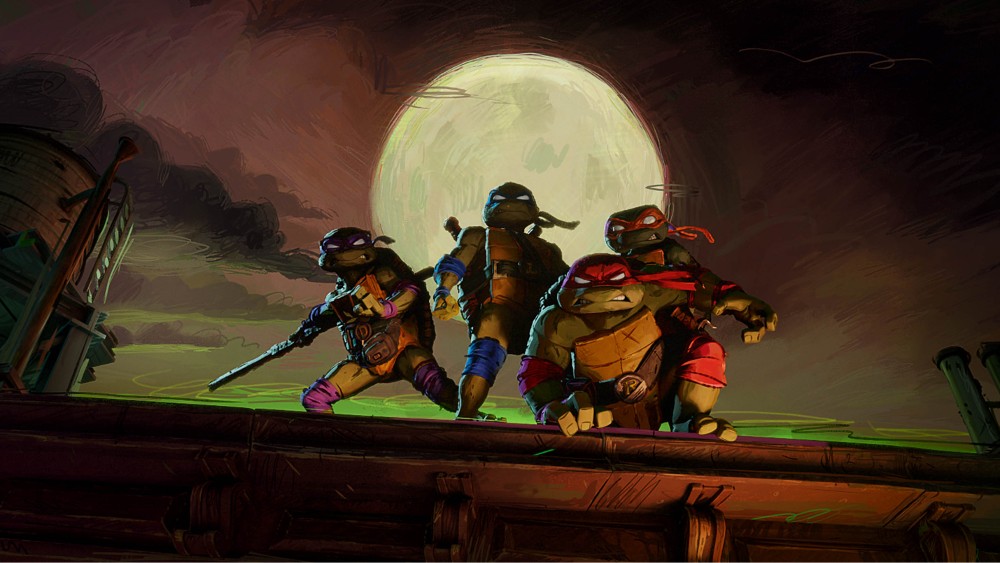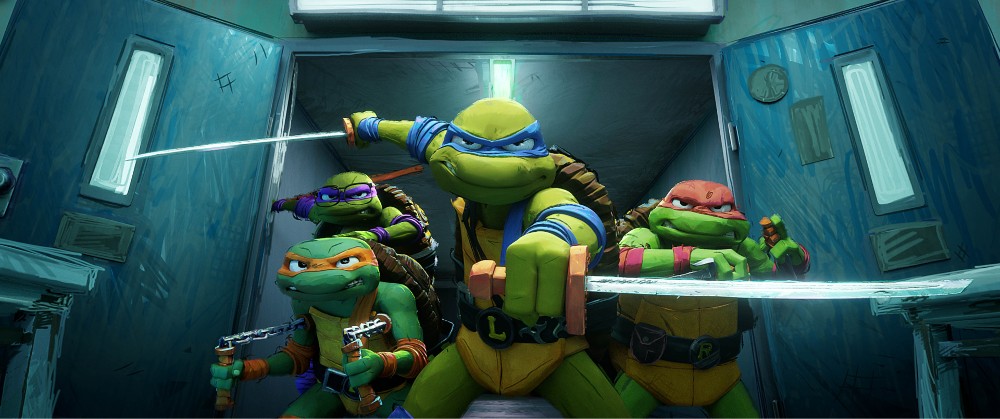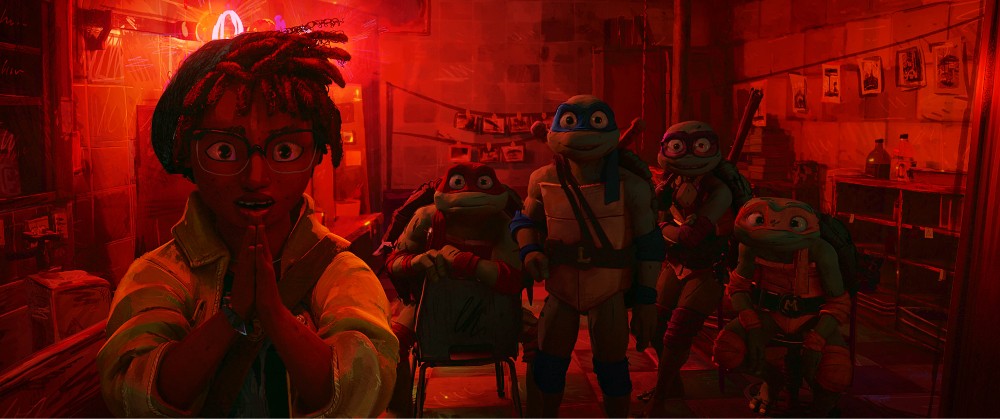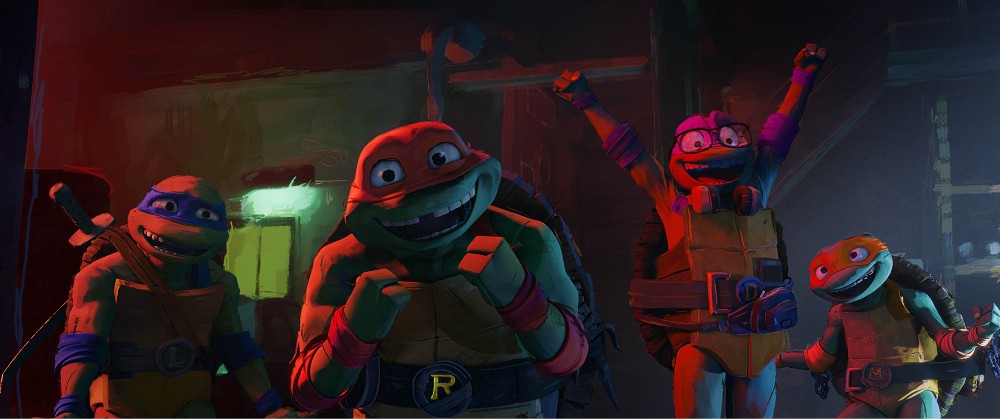
2023 has been a pretty bang-up year for animation so far, with Spider-Man: Across the Spider-Verse being a huge global hit, Pixar Animation‘s Elemental changing how one views that venerable studio’s films, as well as Nimona from Netflix. Plus, we still have Hayao Miyazaki‘s final film, The Boy and the Heron, coming out later this year.
Along comes an unexpected entry into the year’s line-up of innovative animation with Paramount Pictures‘ Teenage Mutant Ninja Turtles: Mutant Mayhem. It’s produced and co-written by Seth Rogen and Evan Goldberg and directed by Jeff Rowe, who directed The Mitchells vs. the Machines at Sony Animation, although it ended up being sold to Netflix due to the pandemic and getting nominated for an Oscar for Animated Feature in the process.
Rowe has put a couple of twists on the Turtles, the first one being to cast younger actors, mostly unknowns, to voice the Turtles, casting Nicolas Cantu as the voice of Leonardo, Brady Noon as Raphael, Micah Abbey as Donatello, and Shamon Brown, Jr as Michelangelo. They’re surrounded by much bigger names as the mutant villains, including Ice Cube, John Cena, Rose Byrne, Maya Rudolph, Rose Byrne, and Rogen himself, with Jackie Chan voicing the Turtles’ mentor figure, Splinter.
Considering the popularity of Mitchells, it may come as less of a surprise that Mutant Mayhem is also the very first TMNT movie to get positive reviews, despite the long-standing popularity of the characters created by Kevin Eastman and Peter Laird back in 1984.
Below the Line spoke with Rowe over Zoom as he visited Paramount Pictures‘ offices in New York City last week.

Below the Line: When were you pitching or approached to do Teenage Mutant Ninja Turtles? Had Mitchells already been sold to Netflix?
Jeff Rowe: I actually wasn’t fully finished with that. I was trying to get ahead of it. Deals take so long in Hollywood, and it takes so much time to plan things, that when I got an agent, I was like, “Let’s find my next project” In that initial phone call, he was like, “Do you like the Ninja Turtles?” I was like, “Yes, I love them.” “Do you like Seth and Evan movies?” “Yes, of course.” He’s like, “They’re doing a Ninja Turtle movie, they need someone like now. And you probably won’t get it…” I was like, “Well, let’s talk about that.”
I started doing meetings way earlier than I expected. Thankfully, because we had moved to work from home at that time, I was able to just hop on a zoom for 15 min, and do these interviews, and not have to drive back and forth across town to meet people in person. I just went through this series of video game boss battles with increasingly more important people, until finally met with Seth and Evan, and had a conversation with them. I think we really clicked over the vision for the film and making it authentic and naturalistic, and making the Turtles feel like realistic teenagers. And then I started doing pre-production on this, as I was winding down post on Mitchells.
BTL: You seem fairly young, so probably the right age to see the original movies in the ’90s. I’m not sure what your background was with the Turtles.
Rowe: I’m 36, so I was the perfect age for those movies to come out, and then to mean every everything to me – Ninja Turtles was my favorite thing as a kid. The bedsheets, the toys, I had everything, and they were my best friends. I loved the Turtles, and they taught me to be a fan of something. It was the first thing I ever was like, “Oh, my identity is a Ninja Turtle. That’s what I love. That’s who I am as a person.”

BTL: What was your big pitch as far as doing an animated Turtles movie? There had been at least one other animated feature, and then, of course, all the TV cartoons, so there’s definitely very specific animated Turtles stuff from the past.
Rowe: It was making something that is really leaning into the “teenage,” so casting real teenagers, doing an art style that almost looks like it was created by teenagers, that’s impassioned but imperfect is kind of how I would describe it, and just trying to make it hopefully, more authentically teen then the franchise has ever been before, and even more so than I think I’ve seen a lot of Western animated films.
BTL: How did you go about casting these teenagers? I was also curious whether you tried to record them together to get that chemistry between them?
Rowe: We did a whole casting search with 300 something open casting call auditions. I went through all of the tapes, and then, quickly honed in on a top 20, 30, and then we did some chemistry reads and some callbacks. Very quickly, Brady, Shamon, Nick, and Micah rose to the top. When we did a chemistry read with them, they came alive, and we’re like, “This is such a good group of kids.” They each embody their Turtle in new and unique ways.
At first, we tried recording them individually, and it was good, because they’re really talented actors, so they did a good job. But it just wasn’t 100% what we were looking for, and Seth was like, “We have to record them together.” He and Billy Eichner had done some voice-over sessions together when they did Lion King. We pushed for that, and it’s difficult, and no one wants to do it. Audio bleed-over is a major issue, it’s hard to schedule, but the first time we got them in a room together, it just crackled with electricity.
It was so alive, they said so many things off-script, and then we’re like, “Let’s just throw the script away and do all of that. This scene needs to be about this, how would you say it?” And then we would just improv through everything together.
BTL: Did you get angry emails from Jacob Tremblay or Brooklyn Prince’s agents, asking, “What about our clients?”
Rowe: That’s an interesting thing about working on a big IP like Ninja Turtles, as opposed to Mitchells vs. the Machines, there are people who want to do it. I didn’t know, would Ice Cube agree to do this? We talked to him, and he loved watching Ninja Turtles with his kids when they were growing up, and he has a personal connection to it. So much of the cast did. Jackie Chan, he knew what it was. I think having it be something like this, and also having Seth attached, who knows everybody and everybody seems to have a high opinion of [him], we were able to assemble a really all-star cast, who all were really dedicated and did a great job.

BTL: Have any of the cast even had a chance to meet each other yet? I’m not sure if you had a premiere before the strike, but I assume most of the actors other than the teens recorded separately.
Rowe: Some of the cast have seen it, but there’s no premiere. I don’t think we’re gathering everyone together to watch it, which is sad for me as a filmmaker. It would be fun to have a premiere. Mitchells, they didn’t have a premier, because of COVID, but at the same time, what they’re striking for is so important and so necessary. I’m happy to forego a premiere, if it helps the ultimate cause of being compensated fairly for what’s changing the industry right now.
BTL: You’re going to have so much fun at your first premiere whenever that is. I’m quite familiar with the DreamWorks and Pixar methods for animating, doing the voice work first and/or doing animated storyboards. How did you approach this one? Did you do all the voice work first or storyboards, etc?
Rowe: It’s a mess, but I love the chaos, and it’s my preferred way to work, just staying flexible. We would storyboard a scene based off a script, and then, in the process of storyboarding it, we would record it, and then, in the record, we’d go wildly off script. By the time that we have to edit the voices into the storyboards, they’re no longer relevant, because we’ve changed it. So then, we have to re-storyboard it to support the voices, and then also, when we re-storyboard it, we’re like, “Oh, wouldn’t it be cool if we did this?” and then we have to re-record voices to support the storyboards. It’s just this constant back and forth dialogue between departments, all in effort of making just the best film possible.
BTL: Which animation houses did you use? Did you work with Nickelodeon’s in-house animation department?
Rowe: No, we started with this vendor studio called Mikros, that had offices in Montreal and Paris. They were so talented and so collaborative, and then later brought in Cinesite to do additional work on the film, and they did such a great job. They have so much good animation in the movie. We had people working in so many different time zones, but we really tried to treat the vendors… usually, the relationship between Nickelodeon and the vendor studios is like, “Here are the targets, do this, give it to us by this day.” We were like, “No, you’re artists, you’re filmmakers. We want you to collaborate, and we want you to be emotionally invested in what you’re working on.”
The animators would try things and experiment. Everyone who’s seen the film talks about whip pans, they have this cool blurring effect. That was not something we created; that was just the artists at Mikros, who were like, “Hey, What if the motion blur looked like this? Would that be cool?” And we were like, “Yes, that’s amazing. That makes the film so unique. Please do.”
BTL: The animation definitely does look so unique, almost painted, which is very cool. Who was your production designer, and who did you work with to create that look, or was it just different animators and artists who put it together?
Rowe: Our production designer was Yashar Kassai, who is so talented, and is a master of light and color. He has so much formal art training, but he has very strange tastes, and I have very strange tastes. Together, we were able to push forward things that were very different, but executed at a high bar of quality. This artist, Woodrow White, who character designed so much in the film, he had never worked in animation before we hired him. He has this really amazing style of drawing that’s like so disrespectful of formal art training. It’s just totally irreverent. If he draws us a building, the perspective’s all broken, but not in a way that looks flawed or bad or naive. It just looks really cool. We were like, “Wouldn’t it be cool if this building looked like a Woodrow drawing? Let’s figure out how to do that.”

BTL: As a lifelong New Yorker, I really loved how New York looked in the movie. Was there any shooting of real locations and rotoscoping stuff?
Rowe: A couple of our artists just happened to take trips out here during production, and when they would go I would be like, “I’ll pay you, just take so many photos. Photograph things,” and we really researched on that. Because we started in [the] pandemic, it made it hard to do a group research trip to New York, but Google Maps was our friend. In early versions, a lot of the movie took place in high school, and I found this website, that has reviews of all the public schools in New York, and it has these photos of the insides of these buildings. I was downloading those off the Internet to create reference, and there’s that show, How To with John Wilson on HBO. That is just all this found footage of New York, and then we would watch that and pick out details, and be like, “Scaffolding is such a thing. There’s scaffolding everywhere in New York. Let’s make sure we’re putting scaffolding in front of the buildings.”
BTL: I felt like I recognized a few of the street corners. Before you go, I have to ask about getting Trent Reznor and Atticus Ross to do the music. I was pretty shocked when I saw their names in the end credits, since I’m used to them doing serious dramas, but this is an animated action-comedy. How did you pitch this to them and get them on board?
Rowe: I still don’t know. [laughs] I think they were fans of Mitchells, and they were fans of This is the End, so I think they took the meeting, because they were interested in hearing about it, but didn’t necessarily care about it being a Ninja Turtles film, or have any specific intention in doing that. We pitched them the vision, and we pitched them to film, and they were like, “Cool, let’s see a script,” and we’re like, “Great, we’ll send that right over,” and then Seth and I were like, “We have to rewrite this and make this 10 times better than it currently is, because we have to bring our A-game,” because we have so much respect for them artistically.
I think they’re the best composers making music right now – I’m such a fan of their body of work. I think that was the question, too: “I dunno. Are they going to be too serious?” But they really embraced the punk rock teenage energy of it, and they were like, “Can we make some of these songs sound like a garage band?” And we’re like, “Yes, that’s great. Let’s make the music sound like it was made by teenagers.” They were so collaborative, and there were so many things they made funnier through their music, which is not what we would have initially expected. But it was a dream come true to work with them.
BTL: I hope the next time I go see Nine Inch Nails, Trent announces, “Now here’s our theme from Teenage Mutant Ninja Turtles!” That would f*** everyone up.
Rowe: Yeah, just do that at a concert. That’d be awesome.
Teenage Mutant Ninja Turtles: Mutant Mayhem opens nationwide on Wednesday, August 2.





